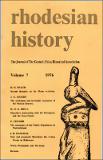| dc.contributor.author | Mufuka, Ken N. | |
| dc.coverage.spatial | Southern Rhodesia (now Zimbabwe) | en |
| dc.coverage.spatial | Northern Rhodesia (now Zambia) | en |
| dc.date.accessioned | 2016-01-08T12:47:51Z | |
| dc.date.available | 2016-01-08T12:47:51Z | |
| dc.date.issued | 1976 | |
| dc.identifier.citation | Mufuka, K.N. (1976) Britain and the amalgamation of the Rhodesias, 1937-1941, Rhodesian History, vol. 7, pp. 85-91. Harare: The Central Africa Historical Association. | en |
| dc.identifier.uri | https://opendocs.ids.ac.uk/opendocs/handle/20.500.12413/7610 | |
| dc.description | A journal article on the amalgamation of Northern and Southern Rhodesia by the British government in the period 1937-1941. | en |
| dc.description.abstract | It is generally believed that the rejection of closer association in Central Africa before 1953 by the British Government was largely to do with the racial policy of Southern Rhodesia. For according to the Bledisloe Commission Report of 1939, the principle of amalgamation itself was acceptable; but before amalgamation could be contemplated as a practical and salutary development, it would be necessary for Southern Rhodesia to show that her racial policy would ‘in the long run prove to be in the best interest of the natives’.1 Most commentators have accepted this view2 but the opening of Colonial Office correspondence for the period 1937-41 makes a closer examination of the question desirable; for the evidence suggests that the native policy of Southern Rhodesia was not the decisive impediment to amalgamation though undoubtedly an important one. The events of these years can now be reconstructed as follows.
At the end of 1937 Huggins wrote to the Colonial Office urging that immediate steps towards amalgamation in Central Africa be taken. The British Government would do him a service if it could announce that it had approved of amalgamation in principle and that steps would be taken sooner or later in order to put that principle into effect. The reason that he gave this urgent request was that he was faced with a rising tide of pro-South African sympathies and that only a counter-move such as he proposed would save his government from being overwhelmed by that tide. The British Government refused to make such an announcement. Huggins then suggested that an alternative was to announce that a Commission of Enquiry would be sent to investigate ways and means of putting the principle of amalgamation into effect; but the Commission would be useful ‘only if it were empowered to report on the advisability of amalgamation, either sooner or later’. Eventually the British Government agreed to send such a Commission which could recommend accordingly but with one provision, known to Huggins only, that the British Government would not be bound to implement the recommendations ‘at any rate in the near future’. | en |
| dc.language.iso | en | en |
| dc.publisher | Central Africa Historical Association, Department of History, University of Rhodesia. | en |
| dc.rights.uri | http://creativecommons.org/licenses/by-nc-nd/3.0/ | en |
| dc.subject | Governance | en |
| dc.title | Britain and the amalgamation of the Rhodesias, 1937-1941 | en |
| dc.title.alternative | Notes, documents and revisions: Britain and the amalgamation of the Rhodesias, 1937-1941 | en |
| dc.type | Article | en |
| dc.rights.holder | University of Zimbabwe (UZ) (formerly University College of Rhodesia) | en |


